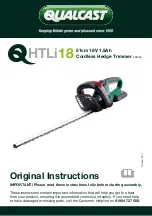
10
ENGLISH
9.
Remove sand, stones, nails etc. found within
the working range. Foreign particles may
damage the cutting tool and can cause to be
thrown away, resulting in a serious injury.
10.
Should the cutting tool hit stones or other hard
objects, immediately switch off the motor and
inspect the cutting tool.
11.
Before commencing cutting, the cutting tool
must have reached full working speed.
12.
During operation always hold the tool with
both hands. Never hold the tool with one hand
during use. Always ensure a safe footing.
13.
All protective equipment such as guards
supplied with the tool must be used during
operation.
14.
Except in case of emergency, never drop
or cast the tool to the ground or this may
severely damage the tool.
15.
Never drag the tool on the ground when mov-
ing from place to place, the tool may become
damaged if moved in this manner.
16.
Always remove the battery cartridge from the
tool:
—
whenever leaving the tool unattended;
—
before clearing a blockage;
—
before checking, cleaning or working on
the tool;
—
before making any adjustments, chang-
ing accessories or storing;
—
whenever the tool starts vibrating
unusually;
—
whenever transporting the tool.
17.
Don't force the tool. It will do the job better and
with less likelihood of a risk of injury at the
rate for which it was designed.
18.
Do not operate power tools in explosive atmo-
spheres, such as in the presence of flammable
liquids, gases or dust.
Power tools create sparks
which may ignite the dust or fumes.
19.
Take a rest to prevent loss of control caused
by fatigue.
We recommend to take a 10 to
20-minute rest every hour.
20.
Do not use the tool on steep slopes.
21.
The shoulder harness must be used during
operation, if supplied with the tool.
Maintenance instructions
1.
The condition of the cutting tool, protec-
tive devices and shoulder harness must be
checked before commencing work.
2.
Turn off the motor and remove the battery
cartridge before carrying out maintenance,
replacing the cutting tool and cleaning the
tool.
3.
After use, disconnect the battery cartridge
from the tool and check for damage.
4.
Check for loose fasteners and damaged parts
such as nearly halfway cut-off state in the
cutting tool.
5.
When not in use store the equipment in a dry
location that is locked up or out of children's
reach.
6.
Use only the manufacturer's recommended
replacement parts and accessories.
7.
Always ensure that ventilation openings are
kept clear of debris.
8.
Inspect and maintain the tool regularly, espe-
cially before/after use. Have the tool repaired
only by our authorized service center.
9.
Keep handles dry, clean and free from oil and
grease.
SAVE THESE INSTRUCTIONS.
WARNING:
DO NOT let comfort or familiarity
with product (gained from repeated use) replace
strict adherence to safety rules for the subject
product. MISUSE or failure to follow the safety
rules stated in this instruction manual may cause
serious personal injury.
Important safety instructions for
battery cartridge
1.
Before using battery cartridge, read all instruc-
tions and cautionary markings on (1) battery char-
ger, (2) battery, and (3) product using battery.
2.
Do not disassemble battery cartridge.
3.
If operating time has become excessively
shorter, stop operating immediately. It may
result in a risk of overheating, possible burns
and even an explosion.
4.
If electrolyte gets into your eyes, rinse them
out with clear water and seek medical atten-
tion right away. It may result in loss of your
eyesight.
5.
Do not short the battery cartridge:
(1)
Do not touch the terminals with any con-
ductive material.
(2)
Avoid storing battery cartridge in a con-
tainer with other metal objects such as
nails, coins, etc.
(3)
Do not expose battery cartridge to water
or rain.
A battery short can cause a large current
flow, overheating, possible burns and even a
breakdown.
6.
Do not store the tool and battery cartridge in
locations where the temperature may reach or
exceed 50 °C (122 °F).
7.
Do not incinerate the battery cartridge even if
it is severely damaged or is completely worn
out. The battery cartridge can explode in a fire.
8.
Be careful not to drop or strike battery.
9.
Do not use a damaged battery.
10.
The contained lithium-ion batteries are subject
to the Dangerous Goods Legislation require-
ments.
For commercial transports e.g. by third parties,
forwarding agents, special requirement on pack-
aging and labeling must be observed.
For preparation of the item being shipped, consult-
ing an expert for hazardous material is required.
Please also observe possibly more detailed
national regulations.
Tape or mask off open contacts and pack up the
battery in such a manner that it cannot move
around in the packaging.
Содержание DUR189RF
Страница 2: ...Fig 1 Fig 2 Fig 3 2 3 1 6 7 8 9 10 11 12 13 12 4 5 Fig 4 2 ...
Страница 3: ...1 2 3 Fig 5 1 2 Fig 6 1 Fig 7 2 1 Fig 8 1 Fig 9 1 Fig 10 1 Fig 11 1 2 Fig 12 3 ...
Страница 4: ...1 2 3 4 5 Fig 13 Fig 14 1 3 1 4 2 4 3 3 2 Fig 15 1 2 2 1 Fig 16 Fig 17 1 2 Fig 18 4 ...
Страница 5: ...Fig 19 6 5 1 2 3 4 Fig 20 1 2 3 4 5 Fig 21 1 Fig 22 Fig 23 2 1 Fig 24 1 Fig 25 5 ...
Страница 6: ...1 1 2 Fig 26 1 80 mm 3 1 8 Fig 27 100 mm 3 15 16 Fig 28 2 1 3 Fig 29 Fig 30 Fig 31 1 2 Fig 32 6 ...











































